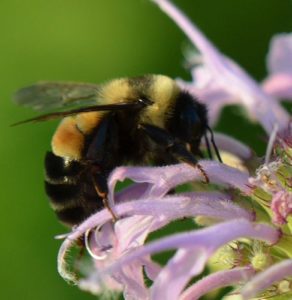Recently, the rusty patched bumble bee (Bombus affinis) made history when the U.S. Fish and Wildlife Service listed it as this country’s first endangered bumble bee. The rusty patched bumble bee is one of approximately 50 bumble bees native to the U.S. Relatively little research has been done on many of those species, including the rusty patched bumble bee. However, of the research that has been done, many of those studies are showing population declines for the species being studied. In the case of the rusty patched bumble bee, the U.S. Fish and Wildlife Service estimates that decline could be as much as 87%.
The rusty patched bumble bee was once fairly widespread and common throughout the northern half of the eastern U.S. and even extended into Canada. Its historic range included 28 states (Connecticut, Delaware, Georgia, Illinois, Indiana, Iowa, Kentucky, Maine, Maryland, Massachusetts, Michigan, Minnesota, Missouri, New Hampshire, New Jersey, New York, North Carolina, North Dakota, Ohio, Pennsylvania, Rhode Island, South Carolina, South Dakota, Tennessee, Vermont, Virginia, West Virginia, and Wisconsin) and two Canadian provinces (Ontario and Quebec). Since 2000, the number of states has dropped to 13 and it is now only found in one Canadian province. Although Kentucky was one of the 28 states where the rusty patched bumble bee was historically found, it is not one of the 13 states where it has been found recently. In 2012, the rusty patch bumble bee was listed as endangered in Canada.

A colony of rusty patched bumble bees starts from a single queen known as a foundress. The new foundress hatches in the late summer or early fall. When she matures, she will fly away from the colony where she hatched to find a mate. Unlike honey bees, the rusty patched bumble bee only mates with one male. After mating, the new queen stores the sperm and then finds a place to hibernate. Little is known about where they hibernate but it is usually underground in a patch of soft, exposed soil. A few reports have been made of bumble bees, maybe not rusty patched bumble bees, also hibernating in compost piles.
In early spring, the queen will emerge and find an abandoned rodent’s tunnel or similar structure to use as her nest. The queen will then begin laying eggs. At this stage, she is solely responsible not only for laying all the eggs but also for gathering all the nectar and pollen that she and her growing brood need to survive. As the eggs hatch and mature, the new worker bees take over the duties of collecting nectar and pollen and for caring for the young. By late summer, a rusty patch bumble bee colony can be as large as 1,000 bumble bees. That’s huge for a bumble bee colony – most bumble bee species have much smaller colonies. It is even more amazing when you remember that it all started with a single foundress a few months earlier.
In late summer and early fall, the queen will begin laying eggs that will hatch into males and new foundresses. As the males and new foundresses mature, they fly away to mate. It is critical that they mate with unrelated individuals. If a related male and female bumble bee mate, then any males produced from that mating will either be sterile or will result in fertilized eggs that aren’t viable. By the end of the fall, all of the rusty patched bumble bees except for the new foundresses die. That means that the entire future of the rusty patched bumble bees in a given area relies completely on the survival of the foundresses throughout the winter and early spring.
The rusty patched bumble bee has been found in a wide variety of habitats including prairies, woodlands, marshes, agricultural landscapes, and residential parks and gardens. Like other bees, it requires access to flowers throughout its active season which lasts from April to September. Rusty patched bumble bees are classified as short-tongued bees which means their proboscises are relatively short compared to some other species of bees. It also means that they can’t get nectar from flowers that have long, thin corollas like forsythia. Having access near their nest site to a variety of flowers that bloom from spring to fall is especially important for rusty patched bumble bees because they have less than a 0.6 mile foraging radius. In contrast, a honey bee can forage as far as 5 miles away from its hive, although most forage within a 3 mile radius.
The U.S. Fish and Wildlife Service attributes the drastic decline in rusty patch bumble bee populations since the 1990s to diseases, pesticides and herbicides, habitat destruction including the loss of abundant flower resources throughout the growing season, small population dynamics (as the population of rusty patched bumble bees dwindles, the odds of an unrelated male and female finding each other decrease), climate change, and the combination of these and other stressors synergistically causing greater declines. In its species status report, the U.S. Fish and Wildlife Service calculated three risk scenarios for the future of the rusty patched bumble bee (status quo, likely, and better-case). None of the scenarios looked good.
Despite the less than positive outcome of the U.S. Fish and Wildlife Service’s risk scenarios, there are some things that individuals can do to help. First, plant a variety of flowers that bloom throughout the spring, summer, and fall. As you plant, concentrate on native plants because those are the ones that the rusty patched bumble bee has evolved to forage on. These flowers will also help other pollinators as well. Second, limit or eliminate your use of pesticides and herbicides. Although herbicides are designed to kill plants, not insects, research has shown they can have significant negative effects on bumble bees. Third, provide bare patches of soft, undisturbed soil where the foundresses can overwinter. Fourth, participate in projects such as Bumble Bee Watch (http://www.bumblebeewatch.org/).
Bumble Bee Watch is an online, citizen science project where people can take pictures of and report the bumble bees they find. Bumble bee experts verify each sighting submitted and the data can be used to help monitor bumble bee populations. Remember, the rusty patched bumble bee may be our only endangered bumble bee but many other bumble bee species are also declining. In many cases, scientists don’t fully know the range or populations of those species. Even with the rusty patched bumble bee, it is possible that there are undiscovered populations simply because no one has looked there. Who knows, maybe you could find the next undocumented population of rusty patched bumble bees or another species of bumble bee that is declining.
Links to more information on rusty patched bumble bees provided by the U.S. Fish and Wildlife Service.

This article was part of Shannon’s original Kentucky Pollinators and Backyard Wildlife blog which evolved into the blog for Backyard Ecology.

Backyard Ecology: Exploring Nature in Your Backyard
Nature isn’t just “out there.” It’s all around us, including right outside our doors. Hi, my name is Shannon Trimboli, and I am the host of Backyard Ecology. I live in southcentral Kentucky and am a wildlife biologist, educator, author, beekeeper, and owner of a nursery specializing in plants for pollinators and wildlife conservation. I invite you to join me as we ignite our curiosity and natural wonder, explore our yards and communities, and improve our local pollinator and wildlife habitat. Learn more or subscribe to my email list at www.backyardecology.net.

Leave a Reply